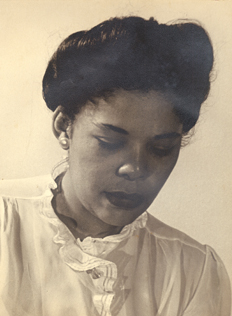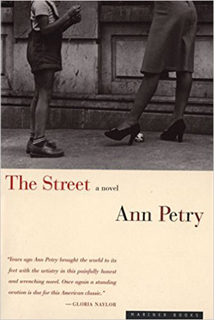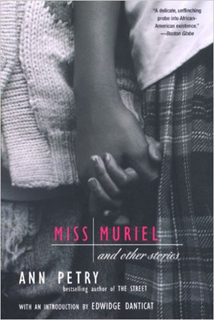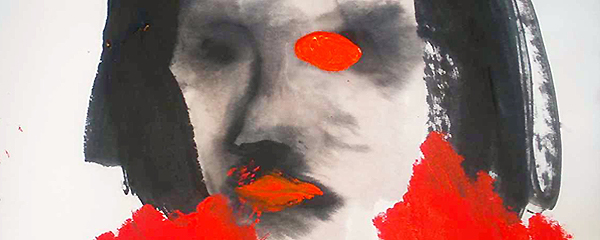
photo © Fett, 2006
by Susan James
Ann Petry left Connecticut for Harlem in 1938. Black, middle-class and well educated, she went to New York to live and to write.
In high school, she had been encouraged by an English teacher who, on reading her work, remarked: “I honestly believe you could become a writer, if you wanted to.” But Petry didn’t, not right away. Instead, she followed in her father’s footsteps and, in 1931, qualified as a pharmacist. It wasn’t the career she wanted, but Old Saybrook, where she lived, was a predominately white community. She understood that the peaceful coexistence with their white neighbours was due, in the most part, to her father’s profession. Peter C. Lane was ‘respectable’. He ran the drug store, dispensing medicines to the townsfolk. This afforded them a more comfortable, more peaceful life than other black families. Petry’s experience of Harlem would later confirm this, and she reflects on it in the short story ‘The New Mirror’.
Everyone knew us for miles around. We were those rare laboratory specimens, the black people who ran the drugstore in the white town of Wheeling, New York, only black family in town except for the Granites.
 Moving to New York with her husband, she found herself living in a black community for the first time in her life. The Harlem of the late 1930s was exciting, but impoverished. It was jazz and soul and blues; its citizens were second class. This Harlem became the inspiration for much of Petry’s short fiction.
Moving to New York with her husband, she found herself living in a black community for the first time in her life. The Harlem of the late 1930s was exciting, but impoverished. It was jazz and soul and blues; its citizens were second class. This Harlem became the inspiration for much of Petry’s short fiction.
‘Marie and the Cabin Club’ was her first published short story. Printed in 1939 in The Afro-American under a male pseudonym, it tells of a cigarette vendor pulled into the world of espionage. The story lacks the bite of her later work, but it shows an astute understanding of the form and a natural aptitude for storytelling:
It was the things he hadn’t said that frightened her. She could see her young body floating in the river, or destroyed in an incinerator or tossed into a busy street in the early morning. True, he hadn’t said any of these things but they were there in his voice, in his cold smile, in his soft laughter.
Between 1941 and 1944, Petry worked as a reporter and editor for The People’s Voice, a leftist newspaper founded by civil rights activist Adam Clayton Powell Jr.; Harlem’s real life stories influenced and informed her own creative writing. In one article, she criticised the Government after it blamed promiscuous black women for the outbreak of venereal disease among white soldiers. Petry saw how black women were often singled out for sexual harassment, intimidation and abuse by both black and white men, and it was a theme she would later visit in her novel The Street. There were women in Harlem who were voiceless, invisible victims until she wrote them into her stories.
He would probably kill her, she thought, and she waited for the feel of his heavy hands around her neck, for the violence of his foot, for he would kick her after he knocked her down. She knew how it would go, for her other husbands had taught her.
~ from The Street
During her time working at The People’s Voice, Petry’s writing came into its own. In 1943, she began attending a creative writing course at Colombia University. In Toward an Intellectual History of Black Women, Farah J. Griffin writes that it was here that Petry learned two valuable lessons, from tutor Mabel Louise Robinson: firstly, how to critique her own work, and secondly, how to incorporate real events into fiction: ‘They can’t just be stuck like raisins … they have to be mixed in.’ And that’s what Petry did. She wrote Harlem as she saw it: the poverty, the racism and the violence. She wrote about its hardship. Her 1945 short story ‘Like a Winding Sheet’ addresses the loss of black masculinity in the face of racism. Petry’s main character in the story, Johnson, is at first presented as a gentle husband. He goes to work, but both during and after his shift experiences racism. Feeling emasculated, he returns home to Mae, his wife, and when she tries to gently nudge him from his bad mood he beats her.
He kept striking her and he thought with horror that something inside him was holding him, binding him to this act, wrapping and twisting about him so that he had to continue it. He had lost control over his hands.
‘Like a Winding Sheet’ was included in Martha Foley’s Best American Stories of 1946, bringing the theme of black male-on-female violence into the literary mainstream.
 ‘In Darkness and Confusion’, written in 1947, saw Petry draw inspiration from the Harlem Riot of 1943. In the story William Jones, a Harlem man, discovers that his soldier son – serving in Georgia – has been sentenced to twenty years hard labour following an altercation with a white policeman on a public bus. Later, Jones witnesses the shooting of a black soldier by a white policeman. Jones realises that obeying white men’s rules isn’t enough to keep any of them safe. What he and his wife do in response changes not just them but Harlem too. ‘In Darkness and Confusion’ wasn’t simply a re-imagining of the Harlem Riot. Petry was angry at the contradiction of US propaganda during the war: black Americans were drafted to fight for American freedoms that they were denied at home. The US armed forces operated under segregation and, while black soldiers were heroes in Harlem, they were often mistreated by the services in which they served.
‘In Darkness and Confusion’, written in 1947, saw Petry draw inspiration from the Harlem Riot of 1943. In the story William Jones, a Harlem man, discovers that his soldier son – serving in Georgia – has been sentenced to twenty years hard labour following an altercation with a white policeman on a public bus. Later, Jones witnesses the shooting of a black soldier by a white policeman. Jones realises that obeying white men’s rules isn’t enough to keep any of them safe. What he and his wife do in response changes not just them but Harlem too. ‘In Darkness and Confusion’ wasn’t simply a re-imagining of the Harlem Riot. Petry was angry at the contradiction of US propaganda during the war: black Americans were drafted to fight for American freedoms that they were denied at home. The US armed forces operated under segregation and, while black soldiers were heroes in Harlem, they were often mistreated by the services in which they served.
In 1943, Petry’s short story ‘On Saturday the Siren Sounds at Noon’ was printed in Crisis Magazine. A man, waiting for a subway train, remembers a recent tragedy and, at the story’s conclusion, jumps in front of the approaching train. Much of the short story is told in flashback, and it’s suffocating. Petry transports the reader from the platform, into his memories and then under the train. The story caught the attention of an editor at publisher Houghton Mifflin. He encouraged Petry to apply for a literary fellowship, which she went on to win with the beginning of a novel set in Harlem: The Street was published in 1946 to critical acclaim. It covered many of the themes featured in her short stories: poverty, single parenthood, sexual abuse and violence. Petry became the first African-American woman to sell over a million copies. The Street had a profound impact on white audiences, but it would never have been published if it hadn’t been for the strength of Petry’s short stories.
 She wrote about black lives, but her characters weren’t heroes or martyrs. They were flawed. They struggled, and they were often desperate. Above all, they were human. Ann Petry’s fiction was always based on a very real truth. But she wasn’t just an observer; she didn’t exploit Harlem for its stories. She was active in the community and she wanted to make it a better, safer place. She joined the Laundry Workers Joint Board and helped prepare a children’s curriculum. She became a recreation specialist and created community programs for families in dangerous areas. The safety of children worried her greatly, and she set up groups to give children a safe place to go to between school ending and the time their parents finished work. She genuinely cared.
She wrote about black lives, but her characters weren’t heroes or martyrs. They were flawed. They struggled, and they were often desperate. Above all, they were human. Ann Petry’s fiction was always based on a very real truth. But she wasn’t just an observer; she didn’t exploit Harlem for its stories. She was active in the community and she wanted to make it a better, safer place. She joined the Laundry Workers Joint Board and helped prepare a children’s curriculum. She became a recreation specialist and created community programs for families in dangerous areas. The safety of children worried her greatly, and she set up groups to give children a safe place to go to between school ending and the time their parents finished work. She genuinely cared.
Ann Petry left Harlem in 1946 and returned to Old Saybrook, Connecticut, where she continued to write and be published. In 1971 came a new collection of short stories, Miss Muriel and Other Stories, which included ‘Like a Winding Sheet’, ‘On Saturday the Siren Sounds at Noon’, and ‘Into Darkness and Confusion’. It is testament to her skill both as a writer and as an observer. She kept a quiet life in Connecticut, but was a popular public speaker, and received a number of honorary degrees. She died in 1997.

